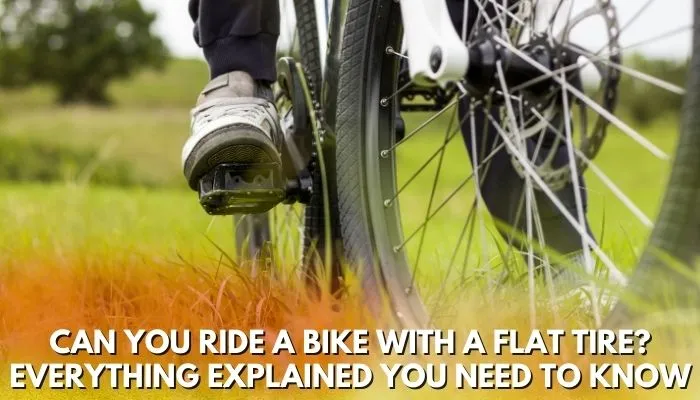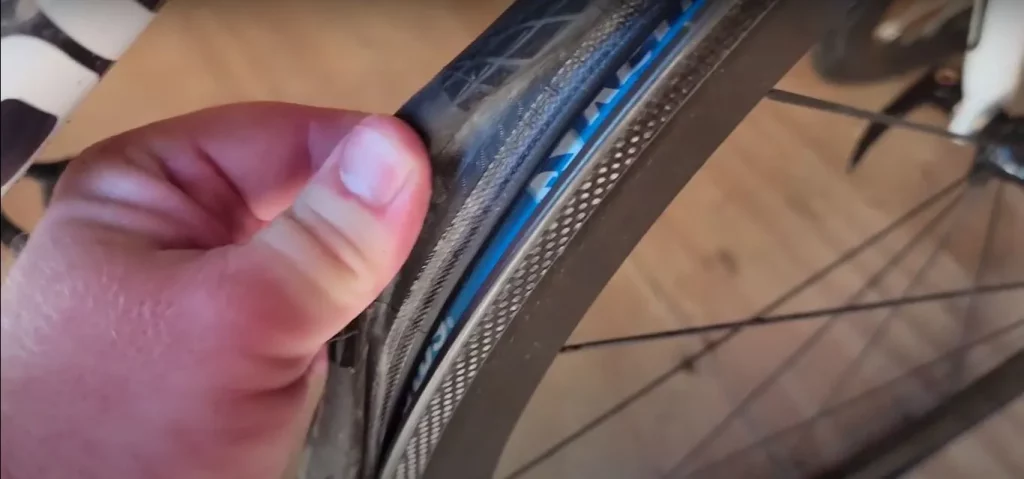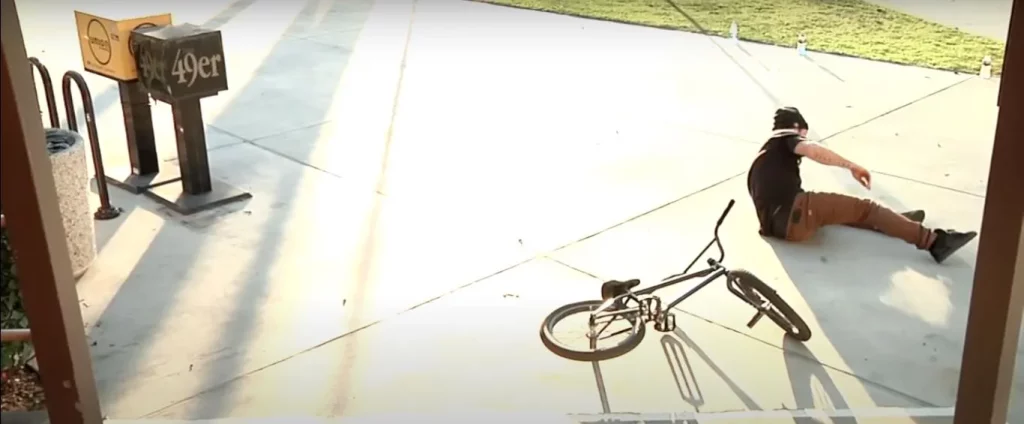Can You Ride a Bike With a Flat Tire? Everything Explained You Need to Know

When you have to replace your bike tire because it is flat, there is nothing more frustrating. And to make matters even worst, it always takes place in a place where it will be raining hard.
Can You Ride a Bike With a Flat Tire
In general, riding your bike with a flat tire is not advised since you risk destroying the wheel frame and inflicting damage on the tire’s sidewalls. On the other hand, if your tires are beginning to lose air, you might ride them to a safe location and carry out roadside maintenance.
Not only is getting a flat tire a major inconvenience, but it might also be hazardous based on where you are. Your options for transport may be restricted, for example, when you are far from home and in the center of a rural area.
Table of Contents
Can You Ride A Bike With A Flat Tire?

Can you ride your bike with a flat tire? Well, it is not advisable to ride a bike with a tire that is completely flat because the metallic wheel rim and frames will start to tear the tire’s thin walls. You will spend more money on a brand-new tire and rim than a fresh innertube. An inner tune will cost around 10 dollars, and a new bike tire will generally cost between 40 and 120 dollars. As a result, it’s always best to refrain from riding a bike with a totally flat tire.
But, if your bike tire is steadily losing pressure due to a small puncture in the innertube, you still can ride it, but your riding, speed, and stability will become worse as more air leaves the tire. If you are out riding and discover that your tire is gradually losing air and you don’t have a puncture tool kit or replacement inner tube, you may be able to continue to ride your bike despite this problem.
You may regularly fill off the air in the innertube to ensure you arrive at your destination if you keep a small pump with you while riding your bike. You could fill up your tire with air if you don’t have a pump handy and happened to cross a gas station or mechanic. With any luck, there will be sufficient air to carry you back in this way. Click here to check out 24-inch bike for what size person.
What Happens When You Ride a Bike with a Flat Tire?

The inconvenience of riding a bike with a blown tire is quite dangerous. In addition to injuring yourself, you could damage your bike as well.
- Bike Damage
Regardless of the severity of the flat tire, if you continue riding your bike in that state, you will certainly damage it more. The wheels and tires are distinct, so keep that in mind. Hence, the rims, as well as wheels, are left exposed and more prone to harm if the tires are not filled properly. Also, riding on the bike will place extra strain and tension on the bike, which might lead to some parts cracking or the bike collapsing.
- Damaged Tires/Tubes
In contrast to a torn tire that can only be thrown in the bin, a flat tire is easily fixed. You can completely ruin the tire and inner tube on a bike when you ride it with a flat tire. Tires cannot adequately resist the effects of rocky roads if they have flat tires. Because of this, riding on a flat tire can ultimately cause damage to the inner tubes.
- Rim Damage
By riding a bike with a flat tire, you might potentially endanger your rims. Rims are sensitive and stiff in ordinary situations, but when tires aren’t covering them, that can change. A complete wheel restoration may be needed after such a rough ride, which will be far more costly.
The rims may fracture if you crash into them violently while riding. The tire will be punctured if you try to mount a substitute tire on a damaged rim. Also, if you ride on bare rims, the spokes in your wheels could crack or come out the other end.
- Frame Damage
Your flat tire does not act as the shock absorber that your bike frame must be safeguarded against. Hence, the increased pressure has the ability to distort or even damage the frame. Due to a flat tire, you don’t want to change the entire bike. But if it did, there is a less expensive alternative you could use in its place.
- Chance of Personal Injury
Riding a bike with a flat tire can harm not only your bike but also you. To provide traction, tires are necessary. In terms of traction on a road or trail, metal rims are hardly adequate. As you’re riding, a flat tire might easily come off the rim, leading to you losing track of your bike and striking anything.
The pressure of the air in your tire keeps it fixed onto the beading located on the inside of the rim, thanks to its outward force. After your tire has lost enough pressure, it won’t be able to stay connected to your wheel and could continue to separate from the bead. It is possible for your tire to entirely come off the wheel if it is not securely attached.
You could have witnessed this occur during a competitive race or even other events. It’s possible for a rider’s tire to blow out noisily when they come into contact with a sharp item or fall violently on a jump.
How Far Can You Ride a Bike with a Flat Tire?
You should be capable of riding for a few miles, at the very least, with a flat tire. In all honesty, you could ride your bike without a tire and still travel a lot of ground. After all, a wheel is still a wheel. Even though it won’t be simple, you can ride with a flat tire for a substantial number of kilometers before the rim is at risk of fracturing.
In general, a few things determine how far you can drive with a flat tire:
- State of the Tires
One of the key elements in deciding how far you’ll be capable of riding your bike is the state of your tires. Your apartment’s quality can have an enormous impact.
Tires can become flat in several different ways. Slow leaks, blowouts, punctures, pinched flats, and other problems still exist. Your ability to go a certain distance will be determined by the type of flat tire you have. A blowout, where all of the air in your tire is gone at once, will prohibit you from traveling as far as a slow leak, for instance (when the air leaks out over a prolonged time).
- Type of Wheel or Bike
The entire wheel of a bike may collapse if sufficient stress or lateral stretch is applied to the rim. Depending on the type of wheel you have been riding on, this may or may not happen. Wheels made of carbon, for instance, are frequently more durable and stiff than alloy wheels, which bend more readily.
A carbon wheel is more likely to fracture upon a significant collision, totally destroying it, as compared to an alloy wheel, which can still be used in an emergency despite it having some minor cracks.
Road bikes lack the wider, more robust rims and thicker tires featured on BMX and mountain bikes. The rims and tires on these bikes are significantly more sturdy because they are intended for acrobatics and difficult terrain. As a result, you can travel further on your flat tire if your rim is more durable.
- Speed
When a tire is flat, riding fast will only accelerate tire deterioration. A flat tire prevents you from going as quickly as you can on a tire that is in good shape. A wheel failure is more likely to take place at a significantly faster rate.
Despite the fact that you may be hurrying to get somewhere, riding your bike at high rates of speed on a flat surface can be dangerous to both you and the bike. You can ensure that you arrive home without incident and that you produce the smallest amount of damage to the bike by riding cautiously.
- Terrain
The type of terrain you are biking on will also impact how far you can go. Some types of terrain might make the journey home simple, while others might cause even more tire degradation. On smooth, flat ground, you will travel the furthest. It will be a really tough ride across the difficult ground with potholes, boulders, dirt, hard ridges, as well as other things of that nature.
- Environmental Aspects
It might be challenging to ride on working tires in weather such as rain, frost, or snow. These circumstances are especially riskier when there is a flat tire. If you’re riding in poor weather, the amount of distance you can ride with a flat tire will be significantly reduced.
For instance, the results of a poll revealed that ice was at account for 26 percent of bike accidents that weren’t collisions! Imagine the harm that would result if you want to include the reduced traction caused by a flat tire in the computation.
- Weight of the Cycle and Rider
The rolling friction of your tires is directly influenced by the total mass of you and your bike. So, the ride will be more difficult the more weight your bike will carry. You can move more gradually on a bike that weighs more. Putting on weight will also do this. You won’t travel very far owing to these considerations as well as the exponential increase at which the tire will leak air.
How frequently do You Get Flat Bike Tires?
On average, you may anticipate experiencing a flat tire every third bike ride. Yet, a flat tire can happen to your bike at any time when you’re riding.
Since the wheels and tires on a road bike are so much thinner compared to those on a mountain or normal bike, road bikes usually have more punctures. The ideal course of action would be to think about replacing your bike tire every 1000 miles and your inner tube every 500 miles.
Alternatively, it can be done when you service your bike. However, the frequency of bike punctures is affected by a wide range of factors. You are more likely to have a flat if you are riding a bike on a road that is uneven, filled with shards and other garbage, and has numerous potholes.
However, the wheels are much thicker with a mountain bike due to the off-roading layout, indicating you should encounter fewer flat tires with the same road surfaces.
What to Do in the Event That You Don’t Have a Repair Kit
Let’s say you are far from home or the closest bike shop, don’t have your repair kit around you, and are in that position. Even if the ground isn’t completely flat, you can still ride your bike.
Nonetheless, it would be best if you utilized any tools at hand to repair the tire in order to ensure that your rim remains undamaged. Finding a different solution is advised if you are unsure about using your flat bike tire.
Conclusion:
So, can you ride a bike with a flat tire? Obviously, you shouldn’t, but the simple answer is “yes.” An enormous amount of damage is caused to the bike when you ride it with a flat tire or a rupture, but you also run the possibility of getting injured.
If you have no other choice and your safety is in danger, you should just ride a bike with such thin tires. The best action to take would be to fix it, ask for backup, or ride your bike back to the house on foot.
